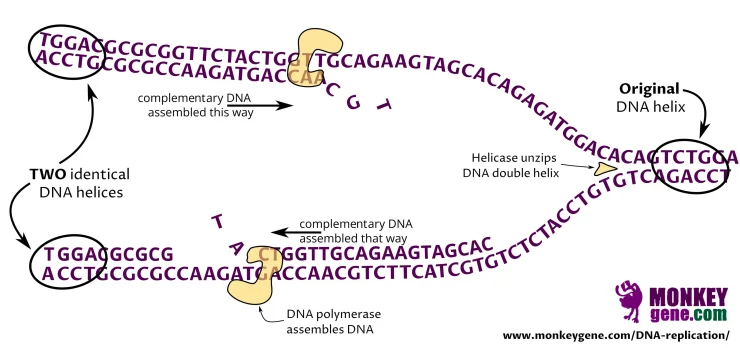While most of us recognize DNA as a blueprint to make life, not everyone knows that it also stores our genetic information and is a basis for inheritance. For offspring to inherit their parents’ traits, the DNA must be copied in a process known as DNA replication.
And that is not all. Your body must copy the whole DNA each time your cells divide. And that happens an immense number of times each day.
Your cells divide a few trillion times each day
Many living beings begin as a single cell. Humans and other mammals start to develop from a fertilized ovum (egg). It contains two copies of each of their genes. One copy comes from their mother, and the other comes from their father. The fertilized ovum then rapidly divides many times over, copying its whole genome (for humans, 21,000 genes plus regions that are not part of the genes) each time.
After the first division, you have two cells. Each of those contains a whole set of your genes. Soon they divide again, and you have a total number of four cells. One division later, it’s eight, then sixteen, thirty-two, and sixty-four. I don’t know about you, but it reminds me of my phone’s internal storage capacity and a story of a guy who invented chess.
Thereafter, the number of cells grows exponentially, doubling every time. After just 14 divisions, the organism has 214 cells. That is a lot of cells, so it’s a good thing that cells do not grow indefinitely and uncontrollably. Division slows down after a while, and old cells also die.
But the fact is, close to a few trillion cell divisions occur in the human body each day. That is a lot of division, and each time the body needs to replicate the whole genome. Insane, if you ask me.
To sum up, an immense amount of DNA copying must go on, and something has to do this work. We’ll find out who does it a bit later. First, let’s review what DNA is.
Divide the double helix…
DNA is a chain of small molecules containing adenine, cytosine guanine, and thymine. For convenience, we refer to them by their first letters: A, C, G, and T. That’s it, only four letters, but their sequence is what makes you different from chimps.
Inside each of your cells (and the cells of other organisms, including plants, insects, and algae) resides machinery that can read the sequence and assemble a new molecule with the same sequence. DNA is a double helix. Before copying the whole DNA, your body must first unzip the double helix and split it into two single strands.
To learn more about the double helix, please see my previous article about DNA.
This is done by an enzyme called helicase, but don’t worry about the term. A helicase is a protein that attaches to the double helix and unzips it.
See this too: What are proteins
The process is more complicated than you might think and to understand it requires mathematical knot theory. Rest assured, tying your shoe is not the only everyday application of this abstract mathematical theory. Your body applies it every day to untie the double helix.
Once the helicase has partially done its job, the two separated strings are available to other proteins.
And, while many are involved, the one you need to know about is DNA polymerase. This enzyme can take up free-floating nucleotides and attach them to a single strand of this unzipped DNA.
…and recreate the other half
Now, the trick lies in the fact that both strands of the double helix are complementary. What does that mean?
It means that though they are not identical, they can complete each other. If you know only one, you can be sure of the sequence of the other.
This is because, in a double helix, an A always sits next to a T, but a G always pairs with a C. Of course, “always” means that rare exceptions can happen.
For example, if you have a sequence AAAC, the complementary one will be TTTG. Can you guess a complementary sequence of CGCGA? Good!
Whenever the machinery attaches to a single, unzipped DNA string, it waits for one of the free-floating compatible nucleotides to come close. There are millions of such free-floating nucleotides in the cell; thus, the “wait” isn’t long. DNA polymerase can copy DNA at a rate of nearly a thousand letters per second.
Once a compatible nucleotide is nearby, the polymerase snatches it, pastes it to an already growing DNA chain, and slides over. Thus it runs along a single strand of unzipped DNA double-helix and recreates the other half. I think a picture speaks better than words.

That, of course, is a vast oversimplification. For example, I did not even mention that one of the polymerases works in the opposite direction.
It is a complication because, while the first one can work continuously, the other one has to assemble DNA bit by bit. Biologists thus call both strands of DNA the leading and lagging strand. But that is merely a technical detail.
Once the machinery has done the work of replication, error correction, and end processing, the cell contains twice the amount of DNA it started with.
All that’s left is to split the cell into two, so each new cell receives one copy of each double helix created. Eventually, all cells in an organism contain the whole set of genes.
The cell can read the genes to make proteins as needed, but this is another story that I will cover in a future article.